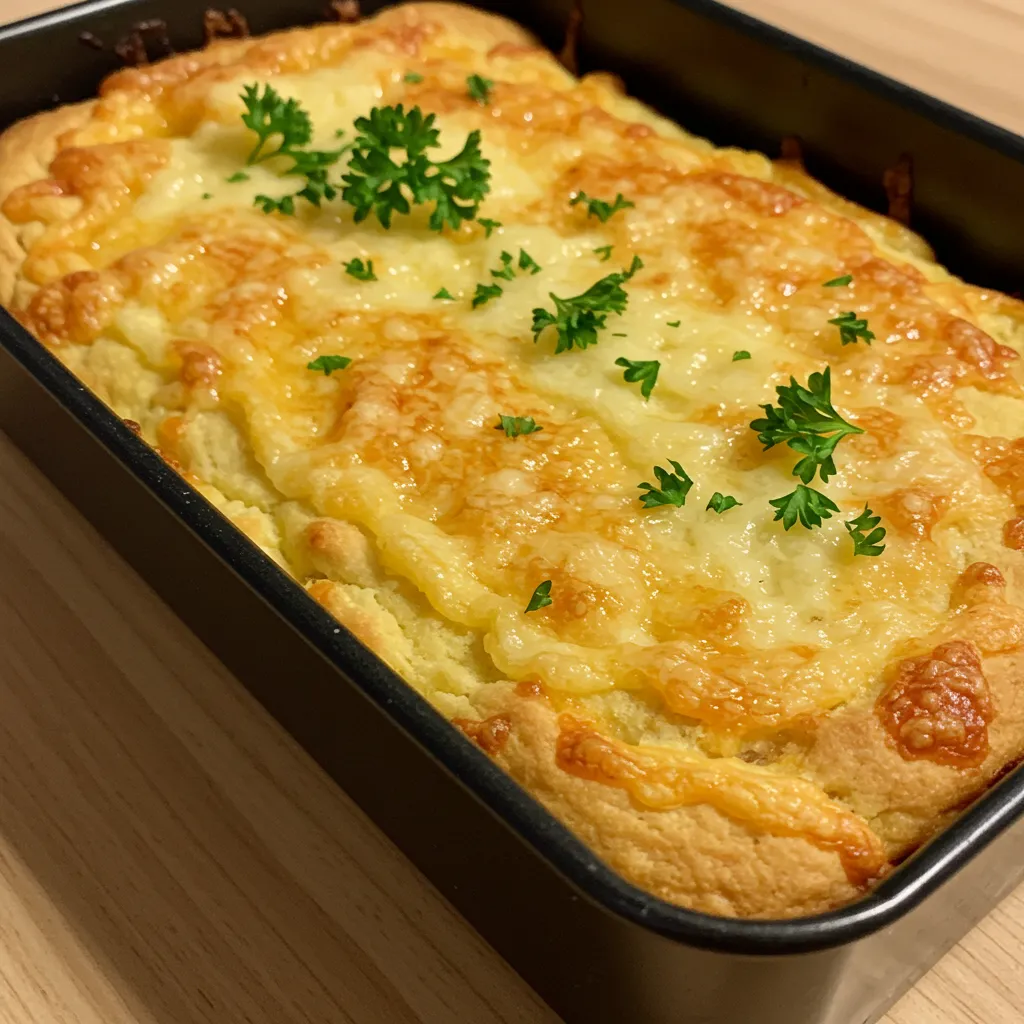This Cheese Biscuit Bread combines the soft texture of American biscuits with the richness of melted cheese, all in a convenient loaf format. Easy to prepare with simple ingredients, this comforting dish is perfect for accompanying soups, stews, or simply as a savory snack. Its golden crust and tender interior make it an immediate favorite for the whole family.
Why You’ll Love This Recipe
- Quick and uncomplicated preparation, ideal for beginner cooks
- Perfect texture: crispy on the outside, soft on the inside
- Customizable according to your tastes and available ingredients
- Excellent for using up leftover cheese in your refrigerator
- Can be prepared in advance and easily reheated
Ingredients
For the Biscuit Dough
- All-purpose flour – Forms the structural base of the bread, providing the characteristic biscuit texture
- Baking powder – Ensures perfect rising for an airy and soft result
- Baking soda – Works in harmony with the baking powder for a light texture and good development
- Salt – Enhances flavors and balances the sweetness of the dough
- Cold butter – Creates pockets of fat that melt during baking, producing tender layers
- Buttermilk – Provides acidity and moisture, making the biscuits softer and lighter
For the Cheese Filling
- Cheddar – Provides a rich flavor and irresistible melting texture
- Mozzarella – Adds perfect elasticity and that satisfying cheese stretch
- Melted butter – Gives a golden finish and additional rich taste
- Garlic powder – Infuses a subtle flavor that perfectly complements the cheeses
- Fresh herbs – Add color and freshness, contrasting with the richness of the cheese
For the Seasoning
- Paprika – Adds mild heat and a beautiful color to the crust
- Dried oregano – Brings Mediterranean notes that complement the cheese
- Black pepper – Offers a slight spiciness that balances the overall richness
- Salt – Amplifies all flavors, particularly important for yeast-based products
Step-by-Step Instructions
Preparing the Biscuit Dough
Start by preheating your oven to 375°F (190°C) and lightly grease a standard rectangular loaf pan. In a large bowl, mix the flour, baking powder, baking soda, and salt. This step of homogenizing the dry ingredients is crucial to ensure uniform rising. Take the butter directly from the refrigerator and cut it into small cubes of about 1/2 inch. Using your fingers or a pastry cutter, quickly incorporate the cold butter into the flour until you achieve a texture similar to coarse bread crumbs. The key is to work quickly so that the butter stays cold, creating the pockets of fat that will make your bread light and flaky. Add the buttermilk and mix gently with a spatula or wooden spoon until the dough just begins to hold together. Do not knead excessively, as this would develop the gluten and make your biscuits tough rather than tender. The dough should remain slightly sticky and irregular.
Preparing the Cheese Mixture
In a medium bowl, combine the grated cheddar and mozzarella. Reserve about a quarter of this mixture for the final topping. To the remaining cheese, add a pinch of paprika, half a teaspoon of garlic powder, and some dried oregano. Mix well so that the spices are evenly distributed throughout the cheese. This combination of seasonings will infuse the cheese with complementary flavors that will develop during baking. In a separate small bowl, melt 2 tablespoons of butter and add a pinch of garlic powder. This flavored butter will be used to brush the top of the bread before adding the final layer of cheese, creating a particularly flavorful and golden crust.
Assembling the Bread
Transfer half of the biscuit dough to the prepared loaf pan, spreading it evenly. Generously sprinkle this first layer with half of the seasoned cheese mixture. Then add the remaining biscuit dough on top, spreading it gently so as not to compact the layers too much. This layering technique creates distinct zones of melted cheese that make each bite flavorful and interesting. Brush the top of the dough with the melted garlic butter, then sprinkle with the remaining seasoned cheese mixture, followed by the cheese reserved for the topping. This final layer of cheese will create a golden, melting crust that is the signature of this dish. For a finishing touch, lightly sprinkle with paprika for beautiful coloration and a little dried oregano for aroma.
Baking and Finishing
Place the pan in the center of the preheated oven and bake for 25-30 minutes, until the top is well browned and the center is completely cooked. To check for doneness, insert a toothpick in the center – it should come out clean with perhaps a few moist crumbs but no raw dough. If the top starts to brown too much before the center is cooked, loosely cover with aluminum foil for the last few minutes of baking. Once baked, remove the bread from the oven and let it rest in the pan for about 5 minutes. This resting time allows the internal structures to stabilize and makes unmolding easier. While the bread is still hot, finely chop fresh parsley or chives and sprinkle on top to add a touch of vibrant color and a note of freshness that beautifully contrasts with the richness of the cheese. Serve hot or warm, cut into generous slices.

Pro Tips
- Use really cold butter and handle the dough as little as possible for lighter biscuits
- For more flavor, add 3.5 oz (100g) of crumbled crispy bacon to your cheese mixture
- Buttermilk is essential for the texture – if you don’t have any, add a teaspoon of lemon juice to regular milk
- Grate your cheese yourself rather than using pre-grated cheese for a creamier melt
- For a lighter version, use reduced-fat cheese and replace some of the butter with Greek yogurt
Storage Tips
This Cheese Biscuit Bread keeps perfectly and can even gain flavor over time. Once completely cooled, you can store it for up to 3 days at room temperature, wrapped in aluminum foil or in an airtight container. To keep it longer, place it in the refrigerator where it will keep for up to 5 days.
To reheat, preheat your oven to 320°F (160°C) and reheat the slices for 5-7 minutes, or use a toaster for individual slices. Avoid the microwave if possible, as it can make the texture rubbery, but if you must use it, reheat at medium power and for short periods.
This bread also freezes very well. Cut it into individual slices, wrap them separately in plastic wrap and then in aluminum foil, and freeze for up to 3 months. To thaw, let the slices come to room temperature and then reheat them in the oven to regain their crispiness.
For a gourmet experience, try lightly toasting the slices and serving them with salted butter that will melt deliciously into the cavities of the bread, or use them as a base for extraordinary sandwiches.
Customization Ideas
The beauty of this recipe lies in its versatility and the many possible variations depending on your tastes and what you have on hand. For a spicy version, incorporate finely chopped jalapeños or a teaspoon of red pepper flakes into the dough or cheese mixture. Mediterranean flavor lovers will appreciate the addition of chopped olives, rehydrated dried tomatoes, and crumbled feta.
For a more substantial version that can constitute a complete meal, add pieces of grilled chicken and sautéed spinach between the layers. An Italian touch can be achieved by incorporating aged Parmesan, fresh basil, and a little pesto to spread between the layers.
The cheese options are endless: try Gruyère for a nutty flavor, blue cheese for a more pronounced note, or a mix of three or four cheeses for a more complex flavor profile. For a milder version suitable for children’s palates, opt for mild cheeses such as Emmental or Tomme.
Fresh herbs like rosemary, thyme, or sage can be incorporated directly into the dough for a deeper and more aromatic flavor. For a luxurious finish, sprinkle with sesame or poppy seeds before baking to add texture and flavor.
Special Technique: The Secret of Perfect Layers
The difference between an ordinary Cheese Biscuit Bread and an exceptional creation lies in the technique of forming layers, a well-kept secret of professional bakers. To master this technique, start by understanding the fundamental principle: the less you handle the dough, the lighter and airier the result will be.
The first key is the temperature of the ingredients. The butter should be cold to the point of being almost hard to the touch, directly from the refrigerator. Some chefs go so far as to place their utensils and bowls in the freezer for 10 minutes before starting. This precaution ensures that the butter particles remain intact in the dough, creating the air pockets essential for the flaky texture.
The incorporation of butter into the flour should be done quickly, ideally with slightly cold fingers or a pastry cutter. The goal is to obtain butter pieces of different sizes, ranging from the size of a small pea to that of a lentil. These variations create differentiated flaky zones that give the bread its characteristic texture.
When adding the buttermilk, the technique is crucial. Rather than mixing vigorously, use a flexible spatula to perform gentle folding movements, as if you were incorporating beaten egg whites into a batter. Stop mixing as soon as the flour is barely hydrated, even if the dough seems irregular. This minimal mixing avoids the development of gluten that would make the bread tough.
For the final assembly, instead of spreading the dough, deposit it by spoonfuls into the mold, naturally creating pockets and irregularities where the cheese will melt spectacularly. This method preserves the air pockets that will expand during baking, creating those distinct layers so characteristic of perfect biscuit bread.
Frequently Asked Questions
Can I prepare the dough in advance?
Yes, you can prepare the dough up to 24 hours in advance and store it in the refrigerator. This can even improve the flavor, but let it rest at room temperature for 20 minutes before baking.
What if I don’t have buttermilk?
For each cup of buttermilk needed, mix one cup of milk with one tablespoon of lemon juice or white vinegar. Let it sit for 5-10 minutes until the milk begins to curdle slightly.
Can my bread be prepared without dairy products?
Yes, replace the butter with vegetable margarine or solid coconut oil, and the buttermilk with plant-based milk acidified with lemon juice. For the cheese, use plant-based alternatives that melt well.
Why is my bread too dense?
This usually happens when the dough has been overworked or if the butter was too warm. Remember that biscuit dough should remain slightly irregular and should not be kneaded like bread.
How can I prevent the top from burning before the inside is cooked?
If the top browns too quickly, loosely cover it with aluminum foil for the rest of the baking. Also make sure that your oven is properly calibrated and that the pan is placed in the center rather than at the top of the oven.

Ingredients
- 3 cups (375g) all-purpose flour
- 1 tablespoon baking powder
- 1/2 teaspoon baking soda
- 1 teaspoon salt
- 1/2 teaspoon paprika, plus a little for sprinkling
- 1/2 teaspoon garlic powder
- 1/2 teaspoon dried oregano
- 1/2 cup (115g) cold butter, cut into cubes
- 1 1/2 cups (360ml) buttermilk
- 2 cups (200g) grated cheddar
- 1 cup (100g) grated mozzarella
- 2 tablespoons melted butter for brushing
- 2 tablespoons chopped fresh parsley for garnish
Instructions
- Preheat your oven to 375°F (190°C) and lightly grease a rectangular loaf pan.
- In a large bowl, mix the flour, baking powder, baking soda, salt, and half of the paprika and garlic powder.
- Add the cold butter cubes and incorporate them into the flour using your fingers or a pastry cutter until you achieve a texture resembling coarse crumbs.
- Pour in the buttermilk and mix gently until the dough just begins to hold together. Do not overmix.
- In a separate bowl, combine the grated cheeses. Reserve a quarter of the mixture for the final topping.
- To the remaining cheese, add the rest of the paprika, garlic powder, and dried oregano. Mix well.
- Transfer half of the dough to the prepared pan and spread it evenly.
- Sprinkle this layer with half of the seasoned cheese mixture.
- Add the remaining dough on top and spread it gently.
- Brush the surface with the melted butter, then sprinkle with the remaining seasoned cheese, followed by the cheese reserved for the topping.
- Lightly sprinkle with additional paprika for color.
- Bake for 25-30 minutes, until the top is well browned and the center is cooked.
- Let rest for 5 minutes in the pan, then sprinkle with chopped fresh parsley before serving.
Notes
- The secret to a good biscuit bread is to handle the dough as little as possible once the liquid is added
- For an even more flavorful result, add 2-3 finely chopped green onions to the dough
- This bread is delicious served with soups, chilis, or simply as an accompaniment to a meal
- For a beautiful presentation, cut the bread into thick slices and serve on a rustic wooden board

